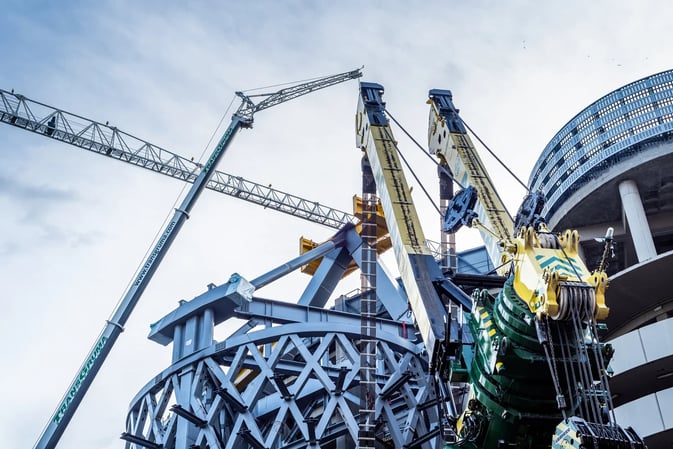What you will find in this text:
- The works at Santiago Bernabéu
- What is expected from Santiago Bernabéu’s maintenance and facilities professionals?
- Lessons that maintenance and asset management in Santiago Bernabéu can provide
For three-quarters of a century, the Santiago Bernabéu stadium has been the home of Europe’s premier football team, Real Madrid. Since 1947, the hallowed turf of the Bernabéu has been trod by such legends as Puskas, Gento, Raúl, Zidane and Ronaldo.
These galácticos have brought Madrid:
- 35 La Liga titles;
- 19 Copa del Reys;
- 14 UEFA Champions League cups;
- …earning them a position amongst footballing royalty.
Throughout their enduring success, Real Madrid have been cheered on by the Madrileño faithful, who watch, admire and adore from the stands of the towering Bernabéu.
The design and functionality of the Bernabéu has always been in keeping with the legendary status of the team it hosts. Since its construction in the first half of the twentieth century, the Bernabéu has remained a yardstick in the worlds of football and design.
But – as is well understood by both the players and coaches of Real Madrid – enduring success requires constant evolution.
In a football club, squads are tinkered with, matchday tactics are adjusted and formations are rejigged – all with the goal of ensuring optimum performance. As Real Madrid’s football team has evolved, so has its stadium. This is why in 2017 the club approved a half-billion-euro redevelopment of the Bernabéu stadium.
The vast construction project entails a complete remodelling of the iconic venue, ensuring that the Bernabéu will retain its position as a landmark achievement in sports architecture for years to come.
The project will guarantee that the stadium is capable of satisfying the demands of not just the players, coaches and staff of Real Madrid, but also the team’s 272 million worldwide fans, who show their support in-person every matchday, 81,000 at a time.
What does the project involve?
The works at Santiago Bernabéu
One standout feature of the new design will be a stunning remodelling of the stadium’s wrap-around façade. Let’s take a look:

- The New Santiago Bernabéu is clad in a sleek steel casing, onto which lighting and images can be projected.
- The striking new exterior is complemented by a revamped interior, including a new 360-degree scoreboard which allows for a truly multimedia matchday experience.
- The New Santiago Bernabéu also features a cutting-edge retractable roof, which can either the stadium’s interior from hostile weather conditions, or be opened up to reveal the heavens above.
- On top of this, the Real Madrid Museum will undergo an extensive renovation, ensuring that the team’s illustrious past is preserved even as its stadium blasts into the future.
- Perhaps the most ground-breaking aspect of the stadium’s renovation is its trailblazing pitch maintenance system.
What does the maintenance system involve? In between matches, the turf of Santiago Bernabéu can be retracted and stored in a subterranean maintenance area, where it is sustained by a complex mechanical system that provides the grass with light and water.
This futuristic development will allow the New Santiago Bernabéu to be a truly multifunctional venue, capable of hosting the El Clasico derby one night, and a Shakira concert the next.
In short, the remodelling will bring the stadium into, and beyond, the twenty-first century, ensuring that the New Santiago Bernabéu fully lives up to its UEFA-appointed title as one of the ‘elite stadiums’ of world football.
You might be wondering, what does it take to manage an asset of the scale of the New Santiago Bernabéu?
What is expected from Santiago Bernabéu’s maintenance and facilities professionals?
In short, it takes the hard work of detail-oriented, diligent and parsimonious technicians, in unison with dynamic digital software. Managing and maintaining the Bernabéu already posed unique challenges, challenges which have been further complicated by its vast redevelopment project.
The Bernabéu’s management team must thus be capable of catering to the needs of the stadiums various guests, whilst also ensuring the smooth roll-out of the stadium's transformation.
As with any technical undertaking of this size, the devil is in the details. The New Santiago Bernabéu stadium contains a multitude of amenities:
- Bathrooms;
- Restaurants;
- Training facilities;
- Audio-visual equipment;
- Deluxe suites;
- Tourist features.
Its maintenance needs are thus diverse and complex. The stadium requires round-the-clock upkeep, and the matter of its management is complicated by its multifunctionality.
The New Santiago Bernabéu’s management team must be prepared to respond to the unique needs of the stadium's diverse clientele, be they athletes, pop stars or fashion designers. Every event that takes place at the Bernabéu requires detailed planning to prepare for the event, hands-on management throughout proceedings and a complex post-event procedure to clean the stadium and arrange for its next guests.
Management of the Bernabéu thus demands the focussed attention of a team of professionals, who take charge of its cleaning, re-arrangement and maintenance between events.
Lessons that maintenance and asset management in Santiago Bernabéu can provide
But the work of humans alone is not enough to fully service the needs a of a twenty-first-century venue.
The work of the Bernabéu’s management team is thus combined with cutting edge smart technology. Whilst a team of technicians co-ordinate the maintenance and development of the Bernabéu, digital maintenance management software organizes and streamlines their efforts.
Maintenance management software allows maintenance teams unprecedented capabilities to catalogue, track and respond to maintenance and management issues. Its powerful machine-learning technology offers users the ability to predict maintenance issues before they arise, reducing downtime and stress.
Maintenance management software has ultimately been proven to improve productivity, lower outgoing expenses, ensure fairer divisions of labour and improve safety and compliance.

